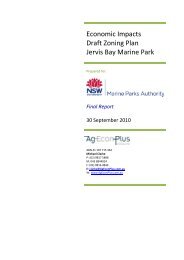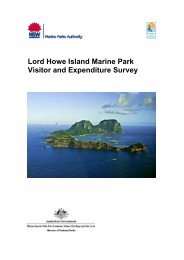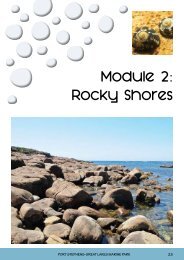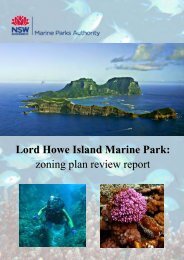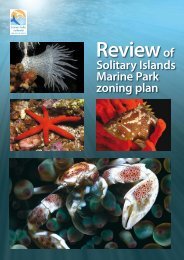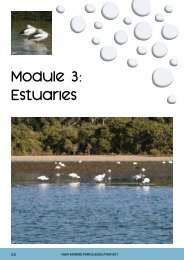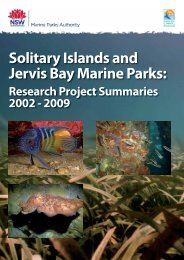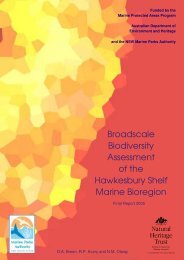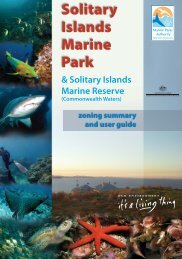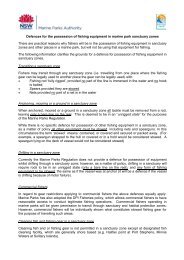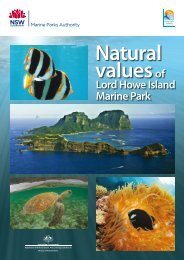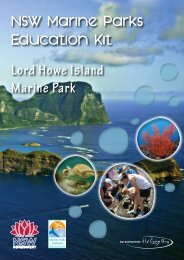Natural values of the Solitary Islands Marine Park - Marine Parks ...
Natural values of the Solitary Islands Marine Park - Marine Parks ...
Natural values of the Solitary Islands Marine Park - Marine Parks ...
- No tags were found...
Create successful ePaper yourself
Turn your PDF publications into a flip-book with our unique Google optimized e-Paper software.
2 Physical environment2.1 ClimateThe <strong>Solitary</strong> <strong>Islands</strong> <strong>Marine</strong> <strong>Park</strong> is situated on <strong>the</strong> north coast <strong>of</strong> NSW. The climateis subtropical, with average air temperatures ranging from 13.9°C in winter to 23.2°Cin summer. Easterly trade winds are dominant and regulate <strong>the</strong> temperature fromSeptember to March, providing warm humid conditions (Zann 2000a). Average rainfallfor <strong>the</strong> area is 1700 millimetres, with most rainfall occurring between December andMay (Copeland et al 1993).Figure 2.Sea surface temperatureimage <strong>of</strong> <strong>the</strong> NSW andsou<strong>the</strong>rn Queenslandregion in January, showing<strong>the</strong> EAC influence in<strong>the</strong> marine park. Imagetaken 19 September1991, Copyright 1999,CSIRO Division <strong>of</strong> <strong>Marine</strong>Research, Hobart.C<strong>of</strong>fs Harbour2.2 Ocean currentsThe oceanography <strong>of</strong> <strong>the</strong> region’s shelf waters is determined by a combination<strong>of</strong> large-scale oceanographic circulation, local wind stress and bathymetry(underwater depth). It is dominated by <strong>the</strong> warm, stratified, nutrient-poor water<strong>of</strong> <strong>the</strong> East Australian Current (EAC), and cooler, well-mixed water from <strong>the</strong> south.The EAC brings tropical and subtropical waters down from <strong>the</strong> Coral Sea, GreatBarrier Reef and sou<strong>the</strong>rn Queensland into <strong>the</strong> more temperate areas <strong>of</strong> <strong>the</strong>continental shelf (Zann 2000b).Sea surface temperature images indicate that <strong>the</strong>warm waters <strong>of</strong> <strong>the</strong> EAC generally dominate <strong>the</strong>waters <strong>of</strong> <strong>the</strong> marine park, particularly those on <strong>the</strong>mid and outer continental shelf, between Januaryand March. During <strong>the</strong> cooler months, <strong>the</strong> marinepark is dominated by cooler inshore currents,although <strong>the</strong>se can also occur in summer due toupwelling (Zann 2000b).The influence <strong>of</strong> <strong>the</strong> EAC <strong>of</strong>ten extends onto <strong>the</strong>coast, creating a southward flowing current inshore(Figure 2). The presence <strong>of</strong> <strong>the</strong> EAC near <strong>the</strong> coastfrequently results in complex currents downstream<strong>of</strong> headlands and reefs, and cooler northwardflowingcounter currents.In <strong>the</strong> marine park, annual maximum and minimumsea temperatures range from about 17°C duringwinter to 27°C during summer (Malcolm 2007),although slightly lower and higher <strong>values</strong> have beenrecorded in some years, mostly due to variations in<strong>the</strong> dominance <strong>of</strong> <strong>the</strong> EAC.Sites near <strong>the</strong> shore such as Muttonbird Island havea lower annual average sea temperature (about20.9°C) than <strong>of</strong>fshore sites such as North <strong>Solitary</strong>Island (about 21.8°C). During summer, <strong>the</strong> watertemperature at North <strong>Solitary</strong> Island is on averageabout 0.5–1°C warmer than <strong>the</strong> water temperatureat North West <strong>Solitary</strong> Island, and 1–1.5°C warmerthan at inshore sites (Figure 3), although <strong>the</strong>temperature differences are reduced slightlyover winter.



